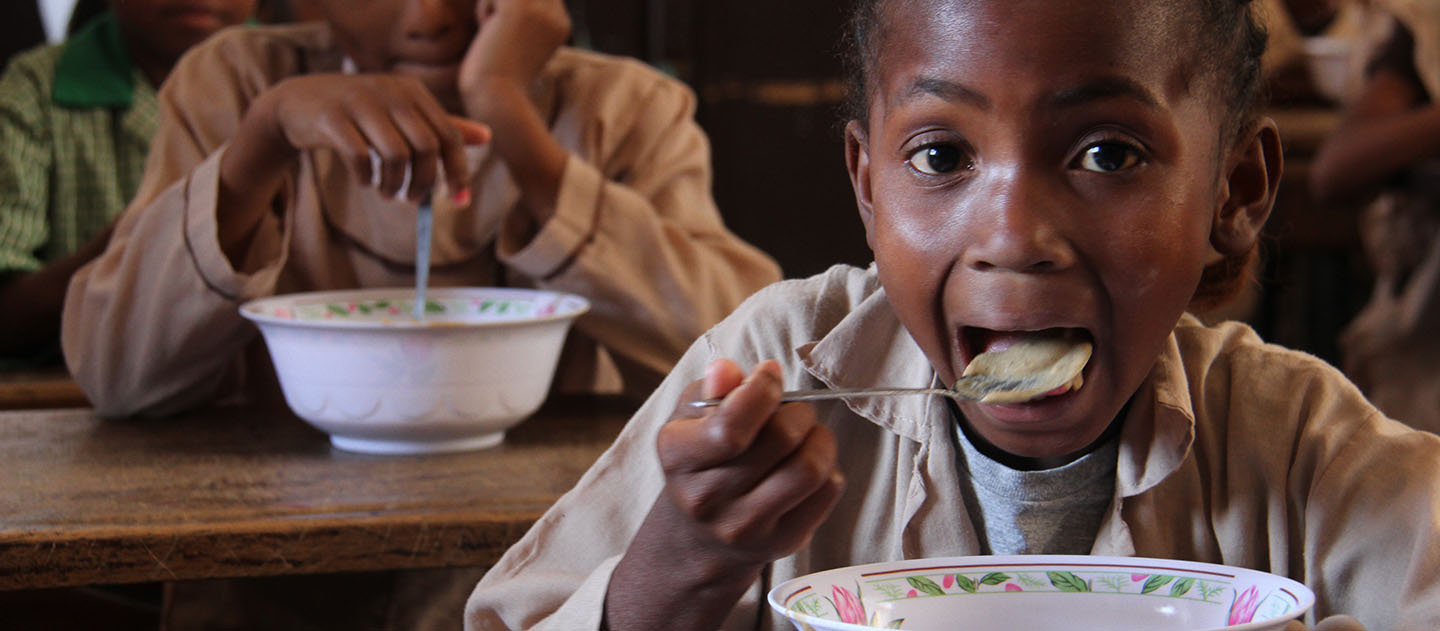Twelve-year-old Branza has lived in an orphanage in Antananarivo, Madagascar’s capital, since 2010, because his parents cannot afford to feed him.
Madagascar is known for its sunny beaches and scuba diving. What many don’t know is that nine out of ten Malagasy people live below the poverty threshold, according to a 2013 World Bank report. Madagascar is among the world’s least developed countries. And the political crisis that hit the country between 2009 and 2013 caused further economic slowdown, and an increase in poverty and marginalization.
Half of Malagasy children are stunted due to chronic malnutrition and severe micronutrient deficiencies. “The rate of chronic malnutrition is still very high in Madagascar,” says Holy Raobelina, Coordinator of the Office for National Nutrition (ONN). “The MDG survey recently reported a national average of 47.3%.”
Two birds with one stone: Fighting malnutrition and improving school results
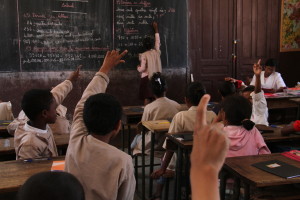 Holy is part of a team of motivated people from the Ministry of Health, the Ministry of Agriculture and Rural Development, the Ministry of National Education, the Ministry of Trade, the Ministry of Finance, and the Ministry of Population, Social Protection and Women Promotion, who are kicking off an ambitious program to fight child malnutrition in the entire country.
Holy is part of a team of motivated people from the Ministry of Health, the Ministry of Agriculture and Rural Development, the Ministry of National Education, the Ministry of Trade, the Ministry of Finance, and the Ministry of Population, Social Protection and Women Promotion, who are kicking off an ambitious program to fight child malnutrition in the entire country.
This program involves reviving the national school feeding system, which was unfortunately abandoned in 2009 due to the political crisis.
To demonstrate that school canteens can indeed improve the state of child nutrition in Madagascar, a 5-month pilot was coordinated by ONN in an Antananarivo primary school between March and July 2013.
During the pilot, school children received a nutritious collation three mornings a week, made of porridge produced locally especially for ONN and composed at 40% of bean flour, 28% maize flour, 17% soya flour, 15% sugar and added vitamins and micronutrients. At the end of 5 months, results showed a slight improvement in the children’s weight, and most significantly a substantial reduction in school absenteeism – from an average of 10 days a month to just 2 days.
Dody Rasoahoby, National Education Director in the region of Analamanga, says: “The standards of living are very low in Madagascar, and children go to school without eating breakfast. School canteens will really help us attract and keep pupils in the classroom.”
Why beans?
For its pilot, the ONN decided to use flour made from a special variety of red marble-seeded beans called CAL98, which are known for their high protein, iron and zinc content.
Rodah Zulu, a CIAT nutrition facilitator based in Malawi, explained that the objective of the pilot was to assess the suitability of using bean composite flour for school feeding programs in all of Madagascar. The flour was developed especially for the school feeding program as part of a partnership between the ONN, the Ministry of Education and a local for-profit company.
The traditional Malagasy diet is very monotonous and dominated by rice (cereals). “There is just too much rice in our diet; we eat rice for breakfast, lunch and dinner. We even drink rice water,” says ONN Coordinator Holy Raobelina. Beans and rice nutritionally complement each other, and beans are widely grown as a rotation crop in rice fields across Madagascar. “We need to diversify our diet, and beans are a good alternative because apart from the grain you can also eat the leaves as vegetables. This is an important source of vitamins, which are also lacking in the Malagasy people,” Holy adds.
However, Rodah explains that to really fight malnutrition and stunting, intervention needs to take place during the first 1,000 days of life, i.e., between conception and the child’s second birthday. “We know that the canteen alone won’t solve stunting issues in Madagascar, but it will certainly improve attendance and the pupils’ performance”.
Raising the awareness of nutrition among families
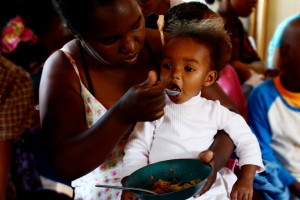
They teach them how to cultivate a kitchen garden and prepare nutritious food.
The national program also includes the creation of community nutrition centers, where a series of activities are organized to inform and support families, and especially monitor mothers and young children during the first 1,000 days of life.
Hasina Rafamantanantsoa, who is responsible for the ONN Community Nutrition Program in Analamanga region in the center of the country, explains that community nutrition officers monitor the weight and brachial perimeter of children aged 0 to 2 years to detect malnutrition, and raise families’ awareness on issues related to vaccination, hygiene, and nutrition. Families also learn how to cultivate a kitchen garden and prepare nutritious food.
These centers exist thanks to the initiative of the government but also thanks to local NGOs and to community chiefs, like Désiré Andrianaivo, who provide a place to host the activities and play a key role in mobilizing community members.
There are 577 such centers in the Analamanga Region, and more than 6,000 in the whole country.
Biofortified beans to defeat micronutrients deficiencies
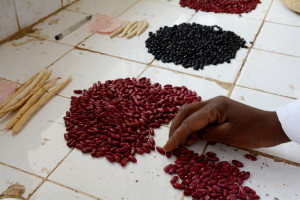
FOFIFA imported 45 varieties of beans through PABRA
In the future, partners in Madagascar’s nutrition program plan to replace the bean variety used for the school porridge with a biofortified variety.
Biofortified beans have higher micronutrient content than normal beans – especially iron and zinc – and are the result of research carried out with PABRA, which is coordinated by CIAT and to which Madagascar belongs through its national research center – the National Center for Applied Research on Rural Development (FOFIFA by its Malagasy acronym). Modeste Second Volombola, researcher at the Agronomic Research Department of FOFIFA, explains that in 2014 FOFIFA imported 45 varieties of beans through PABRA for testing, and selected 20 varieties that could grow in Madagascar for further trial.
FOFIFA is now performing what is called “multi-site plant variety trials” in three eco-regions of Madagascar to ensure that selected varieties grow well in the different production zones of the country under distinct climatic conditions.
Second also tells us that the variety CAL98 (or Vangamena FOFIFA) – the one that was used in the school canteen pilot and also comes from the collaboration with PABRA – is already superior to local varieties. because it gives higher yields, is more resistant to pests and diseases, and has higher iron and zinc content.
“If any of the varieties newly introduced through PABRA happens to be superior to CAL98, we can use it in the future for the school feeding program. If not, we’ll stick to CAL98,” he says.
With plans for school canteens to be implemented at the national level, FOFIFA and partner farmers are already prepared to provide ONN with CAL98 beans in sufficient quantities.
A program that also benefits small farmers
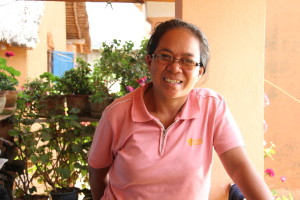
In 2006, Rodine and Roselyne started to work with FOFIFA and received each 600 grams of CAL98 seeds
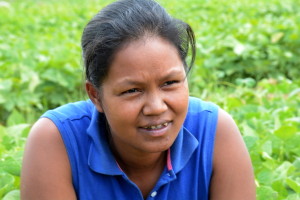 We met Rodine and Roselyne, two female farmers who work with FOFIFA to grow quality, certified bean seeds. In 2006, FOFIFA gave them each 600 grams of CAL98 seeds, which they multiplied and started selling to local seed companies. The production of certified seeds, in addition to egg farming, allows the two women to complement incomes of their husbands, who both work as drivers in the city. Thanks to this activity, Roselyne bought a cow that gives her 11 liters of milk a day and built a two-story house for her family of seven.
We met Rodine and Roselyne, two female farmers who work with FOFIFA to grow quality, certified bean seeds. In 2006, FOFIFA gave them each 600 grams of CAL98 seeds, which they multiplied and started selling to local seed companies. The production of certified seeds, in addition to egg farming, allows the two women to complement incomes of their husbands, who both work as drivers in the city. Thanks to this activity, Roselyne bought a cow that gives her 11 liters of milk a day and built a two-story house for her family of seven.
”I am really happy that ONN chose to use beans for the school feeding program,” confides CIAT’s Rodah Zulu. “This will not only benefit pupils, but also small scale farmers in Madagascar. It will improve their income and, indirectly, improve child nutrition in rural areas.”
Shifting up a gear: From pilot to national school feeding program
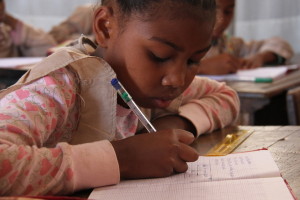
Mihoby, 9 years-old, learned that food contains micronutrients that are essential for growth and health thanks to the nutrition program. Photo: Stephanie Malyon / CIAT
Mihoby, 9, who attends the Ampasandratsarahoby school in Antananarivo, wants to be a doctor when she grows up. Her favorite class is science. Thanks to the nutrition program she learned that food contains micronutrients that are essential for growth and health. She even learned how to grow vegetables in the school’s kitchen garden.
Partners in this initiative want to give Mihoby and all pupils in Madagascar the chance to study in the best conditions, to realize their dreams and develop their country. Now, it’s a matter of finding the necessary funds to implement the school feeding program across the country.
This story was written by Stefanie Neno (CIAT) and was first published on the CIAT news blog on 25 February 2015.
All photographs by Stefanie Neno and Stephanie Malyon (CIAT) are available on Flickr.

